Mitt Romney
The former Massachusetts governor-who has been at or near the front of the GOP pack for much of the campaign-has generated plenty of attention on Twitter. But the conversation about him there was far harsher than in blogs or news coverage.
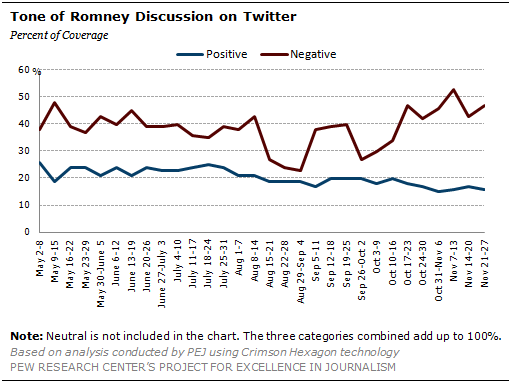
From May 2-November 27, Romney was the second-most discussed Republican candidate on Twitter, the subject of almost 1.6 million Twitter assertions. He trailed only Herman Cain. That is largely in keeping with his rank in terms of attention on blogs-where he was the most discussed GOP candidate-and in the news coverage, where he was the No. 3 Republican newsmaker.
Five of the seven busiest weeks for Romney on Twitter occurred in the final weeks examined in this report, October 10-Nov. 27, the same time frame in which the tone of the conversation has turned more negative.

The overall tone for Romney on Twitter was far more negative than positive-19% positive, 40% negative and 41% neutral. That is distinctly different from and less flattering than the mixed assessments he generated both in blogs (33% positive, 35% negative,32% neutral) and in the news media (25% positive, 28% negative, 47% neutral).
In 20 of the 30 weeks included in this study, the negative assertions about Romney on Twitter exceeded positive ones by at least 15 percentage points. And a good deal of the negative assessments about him stemmed from the familiar theme that the former governor is too moderate for the conservative Republican base.
Given its brevity, certain words tend to show up on Twitter often as political shorthand. In the case of Romney, for instance, a certain "R word," surfaced frequently on Twitter, as in this Tweet declaring simply that "Romney is a RINO." RINO is an acronym for "Republican in name only."
Some of Romney’s better weeks, when the negative conversation exceeded the positive by only single digits, occurred in a three-week period from August 15-September 4 when his negative numbers diminished and the neutral component grew dramatically. But his toughest stretch in the Twitter conversation occurred in the last month, when negative assertions outstripped positive ones by more than 30 percentage points in three of the four weeks.
One of the tweets making the rounds in mid-November was this message from author and humorist Andy Borowitz, alluding to the candidate’s evolving position on some issues: "Romney Admits He is Flip-flopper, Then Denies It."
Newt Gingrich
One candidate whose Twitter narrative has changed dramatically in recent weeks is Newt Gingrich-as he has moved from negative into positive territory and most recently, into mixed.
Overall, the amount of attention paid to him on Twitter has been relatively modest, but that has also changed recently. Outside of the period surrounding his announcement in May, Gingrich’s three biggest weeks of attention on Twitter occurred from November 7-27-when he surged past Cain and even Romney in some polls. In November, only Romney and Cain (the most debated candidate of all) were the subjects of more discussion on Twitter.
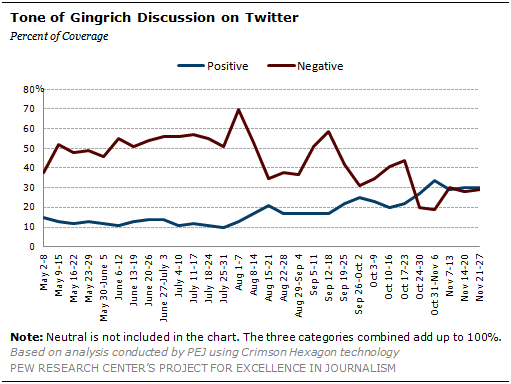
People are not only talking about Gingrich more in tweets in recent weeks, they are also talking more positively. Indeed, after 25 straight weeks in which the discussion about Gingrich on Twitter was more negative than positive-usually by double-digit differentials sometimes as large as 57 points-the Twitter consensus has shifted with Gingrich’s new poll numbers. He enjoyed two clearly positive weeks in late October, though that eased to a more mixed view in November.
Much of that changed narrative can be attributed to Gingrich’s brighter horserace outlook. One November 13 tweet, "Gingrich Becomes TEA Party’s Top Choice," linked to the results of a poll showing Gingrich, at 21%, as the favorite GOP candidate among self-described Tea Party supporters.

For the seven months studied, negative assertions about Gingrich (40%) have outnumbered the positive (21%) by almost 2-1, with another 38% of them neutral. That is somewhat better than he fared on blogs (12% positive, 51% negative, 37% neutral). It is closer to the tone of his narrative in the news coverage (17% positive, 33% negative, 50% neutral). Yet with his surge, the tone on Twitter is still not markedly positive.
Herman Cain
The Twitter conversation about Herman Cain reflected the frantic trajectory of his campaign. Attention to him spiked dramatically in the fall after he emerged as a surprise frontrunner. But the tone of that narrative took a significantly negative turn in the last month of his candidacy when sexual harassment allegations, followed by another woman’s assertion that she had a long term affair with Cain, finally culminated in his December 3 announcement. (In news coverage, the tougher scrutiny began two weeks earlier and initially involved his policy proposals and professional record.)

Driven by an explosion of interest in October and November, Cain also generated more attention in the seven-month period than any other GOP contender on Twitter, with more than two million opinions offered about him. That is considerably more attention than he received in blogs, where he was the fourth-most discussed GOP candidate. The huge increase in recent attention to Cain also made him the No. 1 newsmaker in the news coverage from May 2-November 27.
And nearly three quarters of those Twitter opinions occurred in the period-since October 3-that included his dramatic jump to the top of the presidential polls and the allegations of sexual harassment that broke on October 30 and presaged a subsequent and significant drop in the those same polls.

By the numbers over seven months, Cain fared reasonably well in the Twitter narrative, trailing only Paul and Huntsman in overall tone. On Twitter, 34% of the assertions about Cain were positive, 35% were negative and 31% were neutral. That is generally in sync with the mixed tone of his news coverage (29% positive, 34% negative, 37% neutral) and on blogs (32% positive, 30% negative, 37% neutral). But that only tells part of the story.
Until recently, the Twitter conversation about Cain had been relatively stable from week to week, with his positive assertions outstripping negative ones by anywhere between 10 and 16 percentage points in 22 of the 26 weeks. However, there was a notable turn toward the negative starting in mid-October and he had his four worst weeks from October 31-November 27, with negative opinions outstripping positive ones by at least 14 percentage points in each week.
A number of problems for the Cain candidacy helped drive that negative narrative on Twitter, including the sexual harassment allegations, a viral video of Cain stumbling over a question about Libya and his drop in the polls, where he had been a frontrunner.
Some of the conversation focused on polls. One of the items making the rounds on Twitter was a link to a November 11 Politico story reporting on a McClatchy-Marist poll that had Newt Gingrich vaulting into second place (19%) and Cain dropping to third (17%).
And some tracked the appearance of different women making new allegations. A week later, one of the tweets circulating about Cain said simply, "Woman accuses Cain of bold sexual advance."
Ron Paul
The Texas congressman is a social media phenomenon.
In many respects, the conversations about Paul on Twitter and blogs were similar-and both were different from his news coverage. On Twitter, there were more than 1.1 million assertions about Paul, ranking him fifth among the GOP candidates. He was also the No. 5 newsmaker on blogs. But in the news media, Paul finished next to last in the Republican field in terms of quantity of coverage-ahead of only Santorum.

Paul had several major spikes in attention in the past seven months, including the two weeks in August surrounding his second-place finish in the Iowa straw poll, the week in mid-September when the CNN debate in Florida occurred and the week of October 17-23, when another CNN debate took place. But he had his busiest week on Twitter from November 21-27, which included speculation that Paul would have a strong showing in the January 3 Iowa caucus.
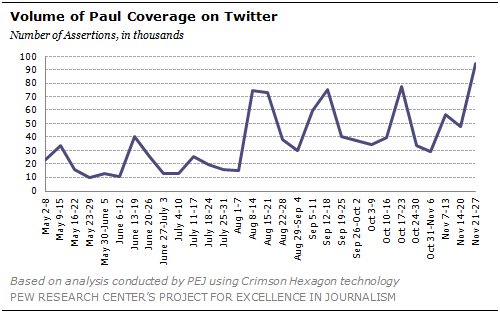
And as was the case in blogs, Paul is the clear winner of the Twitter media primary when it comes to tone. A whopping 55% of the assertions about him were positive, only 15% were negative and 30% were neutral. His closest competitor in terms of positive attention was Cain, well back at 34%. And the candidate with the next lowest percentage of negative assertions was Huntsman, also well off the pace at 24%.
Indeed, Paul is the only candidate who generated more positive than negative assertions on Twitter, blogs and in the news coverage.
On blogs, the assertions about Paul were overwhelmingly positive as well (47% positive, 15% negative and 38% neutral). In news coverage, however, they were more mixed (23% positive, 16% negative and 61% neutral) and the attention to him there was scant.
In none of the 30 weeks included in this report did the margin between positive and negative assertions about Paul on Twitter fall below 29 percentage points. And he enjoyed six weeks where the differential was at least 50 percentage points.
While he has never shown up among the frontrunners in national GOP polls-and most news coverage discounts his chances of winning the nomination-Paul commands an energized online following, as the tone of his narrative on both Twitter and blogs indicates. Indeed, a number of the tweets examined by PEJ offered the simple message: "Vote for Ron Paul."
Rick Perry
Much like Paul, Perry is a good illustration of some of the basic similarities between Twitter and blogs. Both in terms of amount of coverage and tone, the assessment of the Texas Governor in social media is far different from that in news coverage.
The Twitter conversation reinforces the idea that Perry was less of a hot topic in social media than in more traditional news coverage. He generated over 1.25 million assertions on Twitter from May 2-November 27, ranking him fourth among Republicans-behind Bachmann, Romney and Cain. That was slightly below his rank in the blogosphere, where he was the third most discussed Republican. In the competition for news coverage, Perry trailed only Herman Cain.
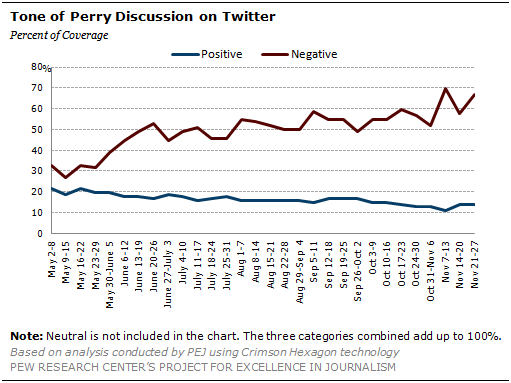
Two of the weeks when Perry received his most attention on Twitter-the period from August 8-21-coincided with his August 13 entry into the race and his instant rise, at that point, to the top of the GOP polls.
The overall tone of the Twitter assessments of Perry was overwhelmingly negative-only 15% positive compared with 55% negative and 29% neutral. (Only Bachmann had a higher percentage of negative opinions offered about her on Twitter during the 30 weeks studied.)
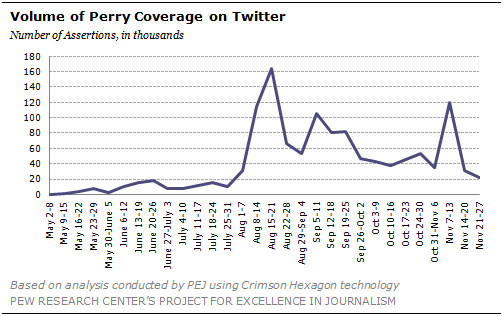
The Perry assessment on Twitter is fairly similar to the one for him in blogs (19% positive, 44% negative, 37% neutral), but very different from the news coverage, where he received more positive coverage (29%) than negative (25%), with 46% neutral.
For the most part, Perry’s narrative on Twitter was relentlessly negative. In 25 of the 30 weeks, the negative conversation exceeded the positive by at least 25 percentage points. In only one week, May 9-15, three months before he announced his candidacy, did that gap narrow to less than 10 points.
The Twitter conversation about Perry has also grown more critical over time as he has slipped from the ranks of the Republican frontrunners. In each of the eight weeks between October 3 and November 27, negative assertions overwhelmed positive ones by at least 39 percentage points-a punishing narrative that happened just once in the previous 22 weeks.
A number of these unflattering tweets took aim at Perry’s difficulties during debates, such as this example-"Rick Perry: Always one question behind."-that was tweeted during the November debate in South Carolina.
Michele Bachmann
Michele Bachmann has generated plenty of attention on Twitter, but she also experienced the harshest assessment of anyone running, including Obama.
The Minnesota congresswoman was the subject of nearly a million and a half opinions on Twitter, ranking her No. 3 behind Romney and Cain. She was the second-biggest newsmaker among Republicans in blogs and No. 5 in news coverage.

Bachmann’s busiest weeks on Twitter corresponded to the major events in her campaign-the announcement of her candidacy on June 27 and the two weeks in August surrounding her first-place finish in the August 13 Ames Iowa straw poll. Indeed, almost one-third of all the assertions about her on Twitter occurred in those three weeks.
But the Twitter discourse about Bachmann so far has been overwhelmingly negative. Only 12% of the assertions about her on Twitter were positive compared with 63% negative and 25% neutral. That is a differential of 51 points in the negative direction and represents the second-lowest number of positive assertions and the highest level of negative assertions of any candidate studied.

Those numbers also stand in stark contrast to the tone about Bachmann seen in news coverage, which was more positive overall than negative (29% positive, 24% negative and 47% neutral).
The Twitter discourse about Bachmann was also much harsher than in blogs, where the discussion about her was 18% positive, 44% negative and 38% neutral-a 26 point differential toward in the negative, roughly half what it was in Twitter.
It is difficult to find a bright period in the Bachmann Twitter narrative. In 27 of the 30 weeks from May 2-November 27, negative assertions about her campaign exceeded positive assertions by 40 or more percentage points. While some candidates saw volatility in the tone of the conversation about them, it is clear that Bachmann was unable to surmount the doubts of her critics on Twitter.
Jon Huntsman
On Twitter, Jon Huntsman was pretty well liked, but not often discussed. Over the seven months since May 2, there have been about 350,000 assertions offered about him. That puts Huntsman ahead of only Rick Santorum of GOP candidates studied on Twitter. (In blogs, he was the least discussed candidate of all and in news coverage; only Santorum and Paul got less attention.)
Huntsman’s biggest spike in coverage on Twitter surrounded his June 21 announcement. And the lack of attention in all three media platforms seems to reflect his standing in the polls, where he has never moved above low single digits.

Huntsman is unusual among Republican hopefuls in that the tone of the conversation about him on Twitter more closely resembled the narrative of his news coverage than in the blogosphere.
He was one of only two candidates to generate more positive attention on Twitter (30%) than negative (24%) with the plurality (46%) being neutral. That resembles the overall tone of his news coverage (21% positive, 17% and 62% neutral), but is far more favorable than the reception he got on blogs-16% positive, 29% negative and 55% neutral.
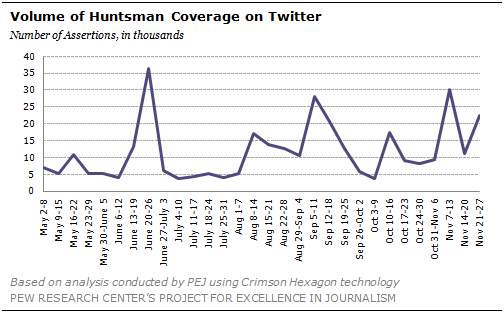
Still, given Huntsman’s status as a lagging newsmaker in all three platforms, it is questionable whether the positive assessments of him on Twitter and in the news coverage have much of an impact on public opinion.
And much of the positive conversation about Huntsman came early. From May through early July, positive assertions exceeded negative ones by at least 10 percentage points in eight straight weeks. In the remaining four months, he had only three weeks when his coverage was that positive.
Two of those weeks, however, were from November 14-27, when there was a moderate surge of positive opinions about him.
Rick Santorum
There was little enthusiasm on Twitter for the former Pennsylvania senator, either in volume or tone.
Santorum received less attention on Twitter than any other Republican (325,000 assertions in seven months). He received the most attention (about 31,000 opinions) from October 17-23, the week of the CNN debate in Las Vegas.

The attention he generated on Twitter also wasn’t generally flattering. He had the smallest percentage of positive assertions (11%) of any GOP candidate studied. And only Bachmann and Perry had a higher percentage of negative assertions than the 52% that Santorum achieved. (Another 37% of the assertions on Twitter were neutral.)
The Twitter narrative for Santorum was very similar to that on blogs-10% positive, 48% negative and 42% neutral. But the conversation on Twitter and in blogs stand in stark contrast to Santorum’s generally mixed narrative in the news coverage of 23% positive, 25% negative and 52% neutral.

And the discussion about Santorum on Twitter was relatively unchanging. In only one of the 30 weeks studied did his negative coverage exceed positive by less than 24 percentage points.
Barack Obama
If presidential elections are referendums on the incumbent, a look at Twitter suggests that is clearly the case with President Obama. There were more assertions on Twitter about the sitting president than all the Republican contenders for his office combined. During the seven months examined, the study identified and analyzed more than 15 million such assertions.
That volume also remained relatively steady most weeks. The President had his busiest week by far (almost 1.9 million opinions) from May 2-8, in the immediate aftermath of the raid that killed Osama bin Laden.
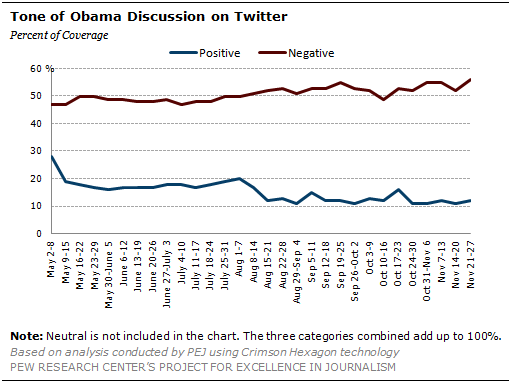
The other distinction about the Twitter discussion of the president is that it was not more strikingly negative than found in news coverage. Indeed, the discourse in blogs, news and tweets about the president bear some similarities.
The narrative is negative. Overall, 17% of the assertions about him have been positive, 51% negative and 33% neutral. In blogs, it was somewhat less critical, 14% positive, 38% negative and 48% neutral. But the ratio of negative to positive assertions was higher, almost 4-to-1 in news coverage (at 9% positive, 35% negative and 56% neutral). It is in news, indeed, that the President received the lowest percentage of positive statements.
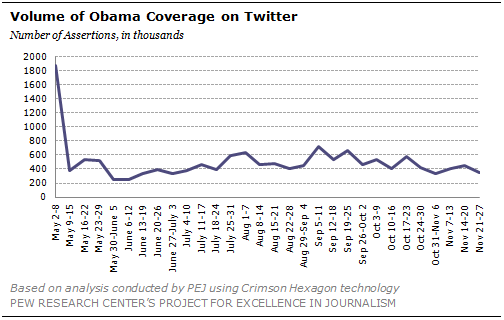
There are some structural reasons that help explain the negative attention to the president in all three platforms, including his association with a steady barrage of unsettling news about the U.S. economy and the fact that he and his policies are regularly targeted by his potential presidential rivals, opponents on Capitol Hill and some disgruntled Democrats.
On Twitter, the president never came close to having a week in which his positive assertions matched his negative ones. But in one sign of Twitter’s tendency to react to events, he had his best week, relatively speaking, from May 2-8, when he hit his high water mark in positive assertions (28%) and tied his low water mark in negative assertions (47%).
That was the week after the death of bin Laden when some tweeters were sending around the congratulatory message: "Obama got Osama."


